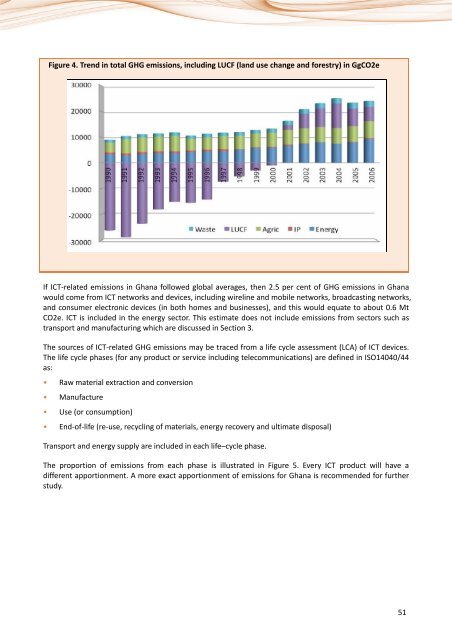Information and communication technologies (ICTs) and ... - ITU
Information and communication technologies (ICTs) and ... - ITU
Information and communication technologies (ICTs) and ... - ITU
You also want an ePaper? Increase the reach of your titles
YUMPU automatically turns print PDFs into web optimized ePapers that Google loves.
Figure 4. Trend in total GHG emissions, including LUCF (l<strong>and</strong> use change <strong>and</strong> forestry) in GgCO2e<br />
If ICT-related emissions in Ghana followed global averages, then 2.5 per cent of GHG emissions in Ghana<br />
would come from ICT networks <strong>and</strong> devices, including wireline <strong>and</strong> mobile networks, broadcasting networks,<br />
<strong>and</strong> consumer electronic devices (in both homes <strong>and</strong> businesses), <strong>and</strong> this would equate to about 0.6 Mt<br />
CO2e. ICT is included in the energy sector. This estimate does not include emissions from sectors such as<br />
transport <strong>and</strong> manufacturing which are discussed in Section 3.<br />
The sources of ICT-related GHG emissions may be traced from a life cycle assessment (LCA) of ICT devices.<br />
The life cycle phases (for any product or service including tele<strong>communication</strong>s) are defined in ISO14040/44<br />
as:<br />
• Raw material extraction <strong>and</strong> conversion<br />
• Manufacture<br />
• Use (or consumption)<br />
• End-of-life (re-use, recycling of materials, energy recovery <strong>and</strong> ultimate disposal)<br />
Transport <strong>and</strong> energy supply are included in each life–cycle phase.<br />
The proportion of emissions from each phase is illustrated in Figure 5. Every ICT product will have a<br />
different apportionment. A more exact apportionment of emissions for Ghana is recommended for further<br />
study.<br />
51

















